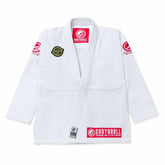Why BJJ Rolling Alone Won’t Build Full-Body Conditioning
Brazilian Jiu Jitsu (BJJ) is one of the most demanding martial arts in the world. It challenges your strength, endurance, flexibility, and mental toughness in every training session. For many practitioners, the natural assumption is that regular rolling, live sparring with training partners will automatically give them peak conditioning for the sport.
But here is the truth: rolling alone won’t build complete, well-rounded physical conditioning. It’s a great tool for sharpening technique and applying strategy. Also, for developing sport-specific stamina. Yet, it leaves gaps in strength, mobility, and energy systems that can limit your performance and even increase the risk of injury.
In this article, you will learn why relying only on rolling can hold you back. We will break down the demands of BJJ, the types of conditioning it requires, and where rolling falls short. We will discuss how to build a balanced training plan that makes you a more durable, explosive, and efficient grappler.
Understanding the Demands of Brazilian Jiu Jitsu
To see why rolling alone is not enough, we need to understand what BJJ demands from your body. Grappling is not just about endurance or muscle strength. It is a full-body sport that requires:
- Aerobic capacity to recover between intense efforts and sustain energy through multiple rounds.
- Anaerobic power to explode for sweeps, takedowns, and submission attempts.
- Isometric strength to hold dominant positions and resist opponent pressure.
- Maximal strength to control scrambles and impose your game plan.
- Flexibility and mobility to move freely in guard, invert, or escape tight spots.
- Grip endurance to maintain control on collars, sleeves, or wrists without fatiguing.
Rolling develops some of these qualities, mainly sport-specific endurance and positional isometrics. But without supplemental training, you will miss out on building the raw power, structural balance, and full energy system development that elite athletes rely on.
Why Rolling Feels Like a Full Workout — But Isn’t Complete Conditioning
Rolling is exhausting. After a few intense rounds, you might feel like you’ve pushed every muscle to the limit. And in a way, you have, but not evenly. BJJ sparring has several limitations when it comes to balanced conditioning:
1- Rolling Is Random and Unstructured
You can’t control exactly what happens in a sparring round. You might spend three minutes defending guard passes, or get stuck under side control the entire round. That means some muscles and energy systems get hammered while others barely work.
2- Rolling Doesn’t Develop Maximal Strength
To build strength, you need progressive overload. You need to gradually increase resistance in a controlled way. Rolling uses your opponent’s body weight and resistance. This is unpredictable and rarely maxes out specific muscle groups in a progressive manner.
3- Rolling Prioritizes Sport-Specific Endurance — Not General Fitness
While it is great for mat-specific stamina, rolling does not always prepare your body for other athletic demands. You might have great endurance in scrambles. But fatigue quickly in strength-based drills or explosive bursts outside of BJJ.
4- It Can Reinforce Weak Movement Patterns
If your technique or posture is not perfect, repeated rolling can reinforce inefficient movement patterns. This can lead to muscular imbalances, overuse injuries, and limited mobility.
The Three Energy Systems in BJJ — and Where Rolling Falls Short
Your body uses three main energy systems during physical activity:
- ATP-PC System (Phosphagen) – Powers short, explosive bursts like takedowns and transitions.
- Anaerobic Glycolysis – Fuels intense efforts lasting 20 seconds to 2 minutes, like submission scrambles.
- Aerobic System – Keeps you going for the entire session and helps recovery between rounds.
Rolling these systems in a mixed, chaotic way. You might hit some explosive bursts, some mid-range scrambles, and long, steady efforts. This doesn't happen in a structured way that maximizes each system’s potential.
For example:
- Your aerobic base might be fine for 5-minute rounds, but lacking for tournaments with multiple matches in a single day.
- Your explosive power might suffer because rolling doesn’t target maximum effort in short bursts. On the other hand, Sprint training or Polymetrics target maximum effort in short bursts.
- Your anaerobic capacity may not improve optimally. Because you are not working at the specific intensity intervals needed to push that threshold.
The Missing Pieces of Full-Body Conditioning in BJJ
Here is what rolling does not fully cover, and why you need additional training.
1- Strength Training for Grappling Power
BJJ involves pushing, pulling, lifting, and holding. But to get stronger at those movements, you need dedicated resistance training. Strength training:
- Builds the maximal force you can apply in scrambles and takedowns.
- Protects your joints and ligaments against injuries.
- Improves muscular balance to prevent overuse problems.
Best choices for BJJ strength:
- Deadlifts and Romanian deadlifts for posterior chain strength.
- Pull-ups and rows for grip and back power.
- Bench press and dips for pushing strength.
- Squats and lunges for lower body drive.
2- Mobility and Flexibility
Rolling often forces your body into awkward positions. Without dedicated mobility training, you may rely on flexibility in some areas while being tight in others. This imbalance can lead to:
- Limited guard retention.
- Higher injury risk during takedowns and transitions.
- Reduced ability to invert, shrimp, or bridge effectively.
Incorporate:
- Hip openers and hamstring stretches.
- Shoulder and thoracic spine mobility drills.
- Dynamic stretching before training and static stretching afterward.
3- Explosive Power Development
BJJ has many slow, grinding moments, but matches are often decided by short bursts of speed. Explosive power is best trained with:
- Olympic lifts (cleans, snatches).
- Kettlebell swings.
- Plyometric push-ups.
- Jump squats and sprints.
Rolling does not give you enough controlled repetitions of explosive movements to fully develop this quality.
4- Grip Strength and Endurance
Grip battles are a huge part of BJJ, especially in the gi. While rolling works your grip, it’s inconsistent. Some rounds may fry your forearms, while others barely use them.
Target grip training with:
- Towel pull-ups.
- GI sleeve hangs.
- Plate pinches.
- Farmer carries.
5- Energy System-Specific Conditioning
To maximize performance, you need to train each energy system separately at times. For example:
- Aerobic base: Long, steady runs, cycling, or low-intensity circuits for 30–45 minutes.
- Anaerobic capacity: Interval sprints, sled pushes, or high-intensity circuits.
- Alactic power: Short sprints of 6–10 seconds with long rest periods.
The Risk of Overtraining Without Balance
If you only roll for conditioning, you might fall into the trap of doing too much high-intensity work without enough recovery. BJJ sparring is hard on the nervous system, joints, and muscles. Without variation, you can:
- Burn out faster.
- Develop chronic aches in the shoulders, elbows, or knees.
- Plateau in strength and endurance gains.
Building a Balanced Conditioning Plan for BJJ
Here is how you can combine rolling with other forms of training for complete physical preparation.
Weekly Structure Example
- Monday: BJJ drilling + rolling
- Tuesday: Strength training (full body)
- Wednesday: BJJ positional sparring + mobility
- Thursday: Explosive power + anaerobic conditioning
- Friday: BJJ drilling + light rolling
- Saturday: Aerobic base work + accessory strength
- Sunday: Rest or active recovery
Strength Session Template
- Squat or deadlift variation: 4×5
- Pull-up or weighted row: 4×8
- Bench press or dip: 4×8
- Grip circuit: 3 rounds (farmer carry, plate pinch, gi hangs)
- Core work: planks, rollouts, side planks
Power and Anaerobic Day
- Power cleans: 4×3
- Kettlebell swings: 4×12
- Sprint intervals: 8×10 seconds, full recovery
- Medicine ball slams: 3×12
Aerobic Base Day
- 30–40 min steady-state cardio (running, rowing, cycling)
- Mobility and flexibility work afterward
Signs You Need More Than Just Rolling
You may be relying too heavily on rolling for conditioning if:
- You gas out in tournaments after the first match.
- You struggle with heavy or explosive opponents.
- Your joints ache constantly.
- You’ve hit a plateau in performance despite training regularly.
The Bottom Line: Train Beyond the Mats
BJJ rolling is essential for skill development. It builds sport-specific endurance, sharpens timing, and teaches you how to apply your technique under resistance. But it is not a complete conditioning program.
If you want to be faster, stronger, more explosive, and more resilient on the mats, you need to complement rolling with structured strength training, mobility work, and targeted conditioning. This balanced approach will give you the edge in both training and competition, and keep you healthier for the long run.







